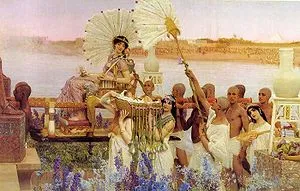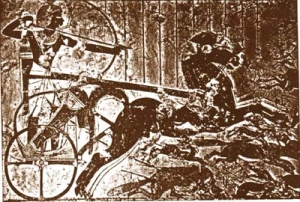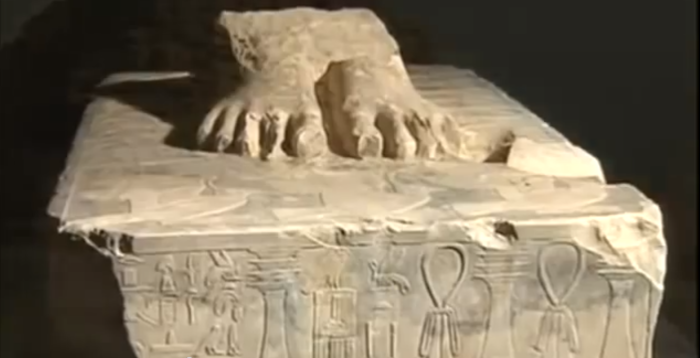Posts Tagged ‘Vizier’
The enigma of chariots in the 3rd dynasty of Egypt is easily explained
The Bible records that Joseph was given a chariot to travel through Egypt.
If Joseph and Imhotep were the same person, this would mean that chariots existed in Egypt as early as the third dynasty.
In the third dynasty, only high officials like the pharaoh and his chancellor / sage / vizier were afforded a chariot to travel in.
Chariots in the 3rd dynasty were not horse drawn, they were carried by a procession of servants.
The Hebrew word ‘merkabah’ in the Bible can be translated as ‘chariot’ or ‘riding seat’. It does not distinguish between a vehicle that is horse drawn or a vehicle that is carried.
In Joseph’s time, this word is better translated as ‘Riding Seat’ as there were no horse drawn Chariots with wheels in the third dynasty.
Horse drawn chariots with wheels were used for military purposes and were not introduced until the late 12th / 13th dynasty.
Most of the chariots of the 12 & 13th dynasty were lost in the Red Sea at the time of the Exodus. Paintings depicting horse drawn chariots in the 12th dynasty would not have survived.
It is hardly surprising then that there are no findings of horse draw chariots before the Hyksos (15th dynasty) unless, of course, one accepts that the chariot wheels found in the Red Sea by Wyatt in 1978 were from the 12th and 13th dynasty.
The Step Pyramid was built on top of a shaft in which Djoser’s Sarcophagus was placed


The empty sarcophagus of Imhotep in a funerary pit connected to the Ibis Gallery. Dating to the time of Djoser, third dynasty, the tomb was orientated to the North indicating Imhotep did not worship the Egyptian Gods. (Jonathan Gray)
forward video to 29min 10 seconds to see the entrance of the Step Pyramid complex. The columns had the shape of a corn cob.
forward video to 33min 10 seconds to see the Grain storage system designed by Imhotep / Joseph.
forward video to 38min 0sec to see the Ibis Gallery
forward video to 38min 35seconds to see Imhotep’s tomb with an empty sarcophagus orientated to the north
The tomb of Imhotep was connected to the Ibis Gallery. The tomb contained a coffin / Sarcophagus that was empty. It was empty because the Israelites took Joseph / Imhotep’s bones with them when they left Egypt at the time of the Exodus. This was Joseph’s (Imhotep’s) wishes before he died.
It was a mastaba type tomb with a burial pit that connected to the animal gallery containing thousands of mummified Ibis birds, falcons and baboons; even bulls.
The Mastaba was orientated to the North indicating that Imhotep did not worship Re.
The sarcophagus had many titles on it that could have applied to Imhotep or Joseph. Pots with the imprint of Zozer were also found in the tomb.
Over a thousand years after his death, Imhotep was deified by the Greeks and the Egyptians.
The pit containing Imhotep’s empty sarcophagus was connected to the Ibis Gallery containing thousands of jars with mummified Ibis birds that were dedicated to Imhotep by pilgrims who visited his tomb in the Ptolemaic period; over a thousand years after his death. People came to the tomb hoping to be healed.
Does anybody know whose feet these are?

A statue thought to be Djoser’s inscribed with Imhotep’s name and titles.
Note the Ibis birds carved on the top of the base
A statue thought to be Djoser’s inscribed with Imhotep’s name and titles
Imhotep, Chancellor of the King of Lower Egypt [3,4,5,6], Chief under the King (of Upper Egypt [3,6]), Administrator of the Great Palace, Hereditary Lord, High Priest of Heliopolis, Imhotep the Builder, the Sculptor, the Maker of Stone Vases [3,4,5,6]
The statue was found by Cecil Firth in 1926 [1]. In 1964 Walter Emery found a tomb close to the Step Pyramid [2].
The tomb contained thousands of pots containing mummified Ibis birds, falcons and baboons [3].
Imhotep’s mummy was never found.
[1] Imhotep the African. Architect of the cosmos.
[2] Tombs of Sacred Animals at Saqqara
[3] Divine creatures: animal mummies in ancient Egypt
[5] The Exodus Case – New discoveries of the Historical Exodus – 4th extended edition – Lennart Moller ISBN 978 87 7247708 4
[6] Chronicle of the Pharaohs – A reign by reign record of the rulers and dynasties of anchient Egypt Peter A Clayton Thames and Hudson 2006 ISBN 978 0 500 28628 9
Did Joseph bury his Pharaoh in a Grain Silo and then build a pyramid on top of it??
At the bottom of the central shaft there is a platform on which stood the Sarcophagus of Djoser. The shaft itself was cased with large limestone blocks and the roof was sealed with a heavy granite slab. The Step Pyramid was constructed above.
Imhotep constructed an elaborate network of tunnels around the central shaft which linked to the main entrance tunnel.
Were these tunnels made to retrieve grain or were they made to throw off grave robbers?
Some of the tunnels actually went beneath the platform for the sarcophagus of Djoser. Why was there a need for a platform? Was the shaft originally used to store grain? Were the tunnels used to retrieve grain from the bottom of the shaft? Did the platform plug the hole in the bottom of the shaft used to access the grain.
Was the shaft first used to store grain and then converted into a burial chamber for Djoser?
Did Imhotep bury the Pharaoh in one of the shafts that he originally made to store grain?
- The entrance to the burial chamber
- The remains of a mudbrick Mastaba situated about one kilometer from the Step Pyramid at Saqqara
- Imhotep designed false passageways and blind ending tunnels to throw off grave robbers.
- The central shaft had similar dimensions to other shafts used to store grain
- The central shaft was the burial chamber for the Pharaoh
- The central shaft was built first, Was it originally made to sore grain?
- Pharaoh Djoser (Netjerikhet)
- A computer generated reconstruction of a mudbrick mastaba that was used as a burial chamber for the first dynasty pharaohs.
- The Step Pyramid was built on top of a shaft similar to the other shafts in the complex used to store grain
- The Step Pyramid was built in stages. At first, just one mustaba sat on top of the central shaft in which the Pharaoh was buried. More mastabas were added next to and on top of the previous ones.
- Was Djoser buried in the first grain silo built by Imhotep?
- Statue of ?Djoser with Imhotep’s name and titles inscribed on it.
- 11 of Djosers daughters were also buried in the Step Pyramid which is just a series of mastabas stacked on top of one another.
- Imhotep
- The Step Pyramid was constructed on top of the central shaft after the Pharaoh was buried in it.
- Could the central shaft have been the first grain silo that Imhotep built for the Pharaoh?
- Imhotep
- This central shaft became the burial chamber for the Pharaoh Djoser (Netjerikhet)
- There are 3.5 miles of tunnels under the Step Pyramid
- The Sarcophagus of Pharaoh Djoser was at the bottom of the central shaft.
- Dr. Zahi Hawass
- Imhotep in heiroglyphics
- Did Imhotep bury the Pharaoh in a grain silo and then construct the Step Pyramid on top of it?
- The central shaft was lined with large limestone blocks which eventually collapsed falling onto and smashing the sarcophagus (about 500yrs BC).
- Imhotep lowered the Sarcophagus of the Pharaoh into the central shaft and then sealed the top of the shaft and built a mastaba on top of it. Then he added more mastabas for the rest of Djoser’s family.
- The Sarcophagus of Pharaoh Djoser was at the bottom of the central shaft.
- Was the Burial Chamber originally a grain silo?
- The main tunnel leading to the burial chamber
The Step Pyramid was built on top of a Shaft in which the Pharaoh was buried. Was this shaft originally used to store grain or was it made for this purpose?
The shaft was cased with large limestone blocks and the top was sealed. A limestone mastaba was constructed over it. Successive layers were then added to the mastaba to bury the rest of Djoser’s family. The final result was the Step pyramid.
In about 500BC the limestone casing in the shaft collapsed, crushing Djoser’s sarcophagus. It was only in recent times that the rubble in the tomb has been cleared and the tomb inspected.
The shaft would have had to have been constructed before the pyramid was constructed.
This means that Djoser must have died and been placed in the shaft before the construction of the Step Pyramid. The famine occurred during Djoser’s life time as did the seven years of plenty. Maybe the shaft was originally used to store grain and later was lined with limestone and used as a burial chamber. A limestone mastaba was contructed on top of the burial chamber and then successive mustabas were added to bury Djoser’s 11 daughters and three wives. The original mastaba was extended horizontally and then vertically (stacking one upon another) resulting in a Step Pyramid which was then faced with nicely cut limestone (which has fallen down over the centuries).
The Bible is silent about what Joseph did for the last 66yrs of his life although the Bible does say that he was able to not only ensure the survival of his family, he was able to protect them as they grew into a great nation numbering over 2 million at the time of the Exodus
Joseph (son of Jacob) is a key figure in the Old Testament of the Bible , who became a vizier (sage / viceroy) for an Egyptian pharaoh and during this time was responsible for saving ancient Egypt from a seven year famine. Joseph was able to acquire all the land of Egypt (except that of the priests) by selling grain during the famine. In this way, Joseph made the Pharaohs very rich. Joseph was only 30yrs old when he became vizier and 44yrs old when he had saved Egypt and bought up all the land. He lived to the age of 110yrs and was given a royal Egyptian burial. The Bible is silent about what Joseph did for the last 66yrs of his life although the Bible does say that he was able to not only ensure the survival of his family, he was able to protect them as they grew into a great nation numbering over 2 million at the time of the Exodus (which occurred 430 years after Joseph’s family entered Egypt).
The identity Joseph in Egyptian history is debated, but some scholars identify him with Imhotep, who was the vizier during the Third Dynasty under Pharaoh Djoser ( also called Netjerikhet / Zoser).
Given Joseph’s position and achievements, one would expect to find some evidence for his existence in Non-Biblical Egyptian records and archaeological discoveries.
Joseph built silos to store grain in key Egyptian cities. Massive underground silos can be found in many cities of Egypt dating back to the third dynasty. [1] [2] [3] It is not unreasonable to suggest that these may have been built by Joseph. In particular, Joseph may have built the silos associated with the first pyramid built in Egypt (The Step Pyramid which is part of the Djoser Pyramid complex at Saqqara, designed by Imhotep). [4] [5] [6] [7]

Large pits can be found within the Step Pyramid complex at Saqqara. The bottom of the pit can be accessed from an adjacent pit that has stairs. It would have been ideal for storing grain and, most likely, it was used for this purpose. It could have been made by the Hebrew vizier Joseph who had many similarities to the vizier Imhotep who designed the Step Pyramid complex. This has caused many historians to propose that Joseph and Imhotep were the same person.
There are many similarities between the profile of Joseph and Imhotep. [8] [9] [10] [5] Imhotep is also credited with saving Egypt from a seven year famine after hearing of the Pharaoh’s dream. Imhotep, like Joseph, was a commoner with some divine connection and was placed second in charge of Egypt by the King (Netjerikhet). [8] Joseph bought up all the land for Pharaoh by selling the grain he stored during the seven years that preceded the famine [11]; a feat that could only have been performed once, early in Egypt’s history, and explains how the Pharaohs became so powerful and able to build the pyramids. Given that Joseph was one of the Patriarchs of Israel, and figures very early in the Biblical record, less than 1000 years after the flood of Noah, it is quite possible that he may have figured in the early parts of Egyptian history, namely the Third Dynasty as the vizier for Pharaoh Djoser. [9][12][13]
Until recently, the most compelling argument against Joseph and Imhotep being the same person, has been the discrepancy between the estimated times during which they lived. [4][14]
Egypt was not always united and sometimes there were different rulers in upper and lower Egypt. Sometimes, a conquering Pharaoh would let regional rulers (Nomarchs) stay on as governors when a new dynasty began (eg 12th dynasty). The division of the kingdom into up to 42 ‘nomes’ (regions or provinces) can be dated back to the Old Kingdom and it continued until the Roman period.
Clearly, there are many problems with the “traditional Egyptian chonology” that assumed the Egyptian dynasties were sequential and did not allow for co-regency and dynasties running in parallel. Evidence is now accumulating to suggest that Egyptian dynasties may overlap and may not date back as far as was once thought. [15][16][17][18]
Egyptian records are not chronological and dates have been calculated from very sketchy notes of third parties who saw the original documents (eg Manetho‘s records in the Alexandrian Library before they were destroyed in a fire). [12] Other documents such as the Turin King list are very fragmented and incomplete. In many cases, all that is known about some pharaohs are their names and how long they reigned. The pharaohs of dynasties 7-11 (the first intermediate period) were not buried in pyramids as were the pharaohs of the Old Kingdom (dynasty’s 3-6) and the Middle Kingdom (dynasty 12). Some pharaohs in this first intermediate period may turn out to be ‘Nomarchs‘ or ‘other high ranking officials’ and not ‘pharaohs’ at all! The result of this is that Egyptian history is probably a lot shorter than previously thought and the pyramids were probably constructed much later than many historians have previously estimated. [19]
If David Down is on the right track with his “modern alignment” of the Egyptian dynasties and allowing for a long sojourn of the Israelites in Egypt of 430 years (Exodus 12:40), it is quite likely that Joseph and Imhotep were the same person, particularly if some pharaohs in dynasties 7-11 (the first intermediate period) turn out to be ‘high ranking officials’ or ‘Nomarchs‘. [20][21][22][23][18]





































